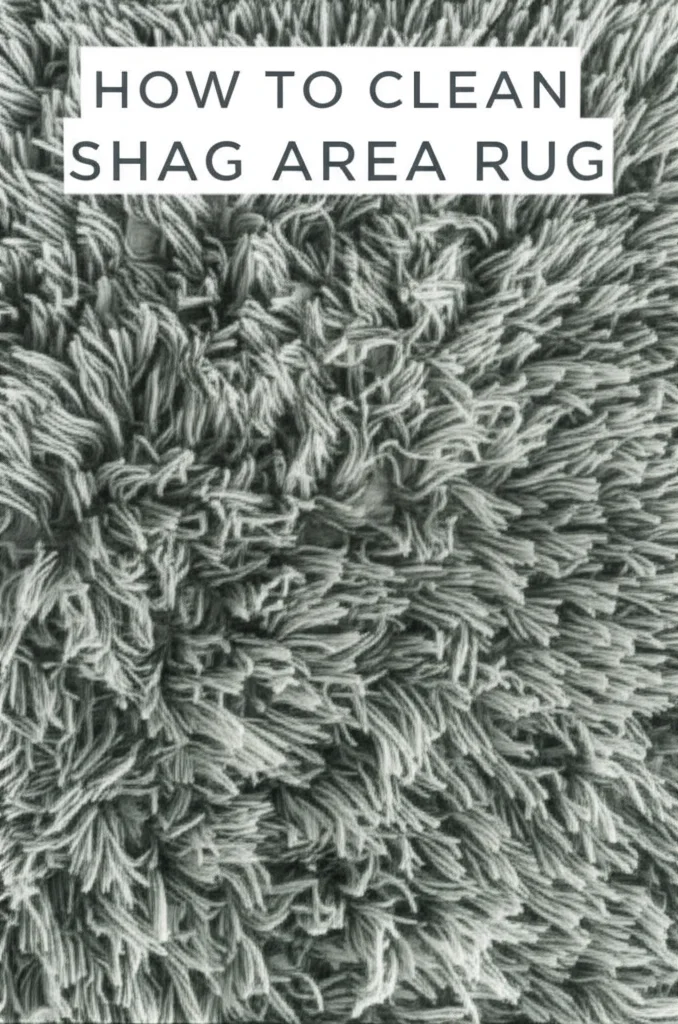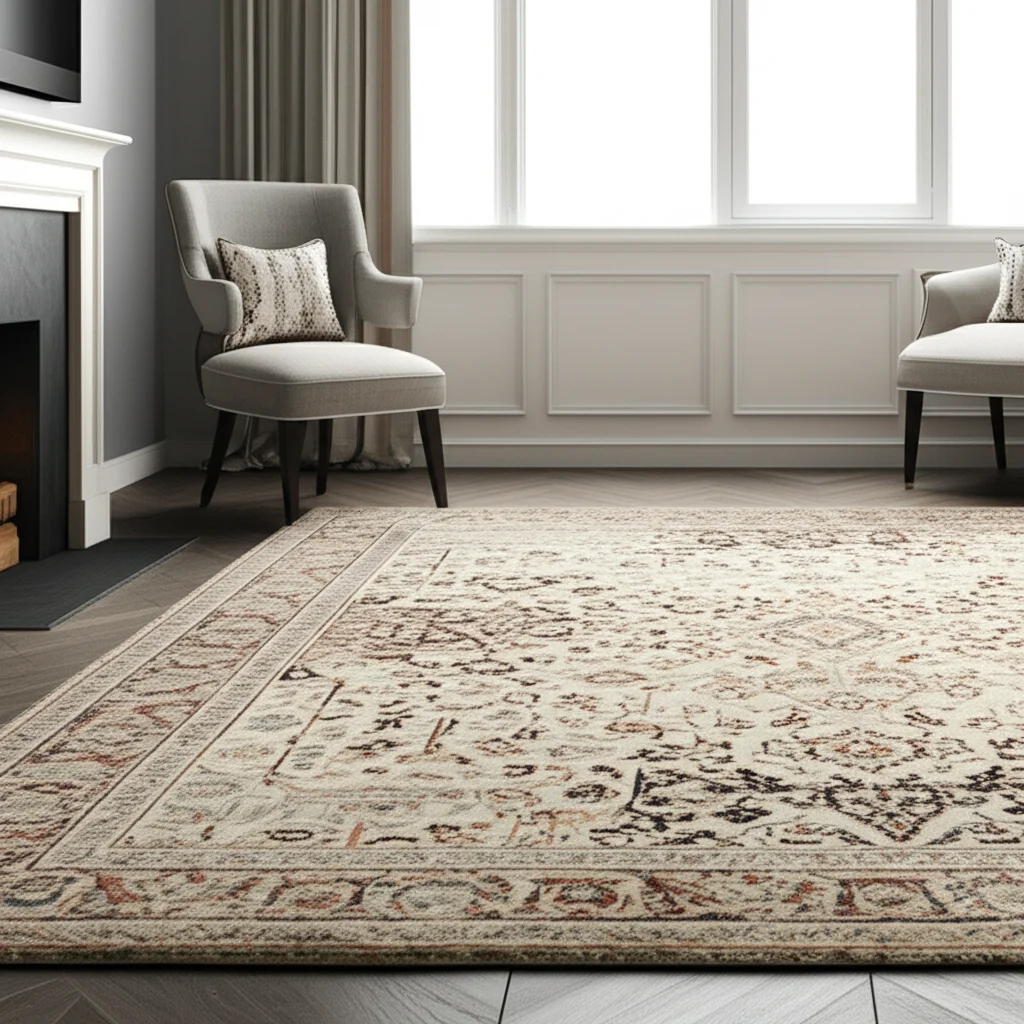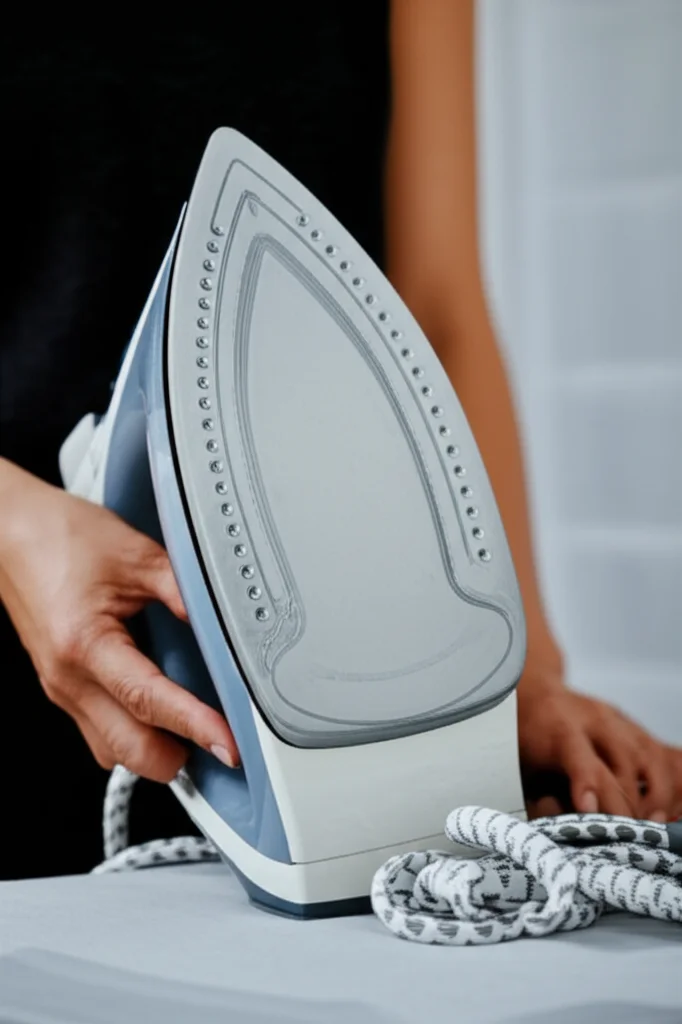· Todd Martin · Home Care · 20 min read
How To Clean Shag Area Rug

Clean Your Shag Area Rug: A Complete Guide
Shag area rugs bring warmth and texture to any room. Their long, soft fibers offer a cozy feel underfoot. However, their unique construction also makes them dirt magnets. Dust, debris, and pet hair can easily get trapped deep within the strands. Cleaning a shag area rug requires specific methods to avoid damage and ensure thorough cleanliness. Traditional cleaning often falls short. I understand the challenge of keeping these beautiful rugs pristine.
This comprehensive guide will show you how to clean a shag area rug effectively. We will explore various techniques, from daily maintenance to deep cleaning. You will learn about different rug materials and how they influence cleaning choices. I will provide simple steps for spot treatments, odor removal, and proper drying. By following these methods, you can keep your shag rug looking fresh and soft for years to come. Let’s make your cozy rug sparkle again.
Takeaway
- Identify your shag rug’s material to choose the right cleaning method.
- Vacuum regularly using a high-pile setting or hose attachment.
- Treat spills immediately with gentle blotting and appropriate solutions.
- Deep clean with dry shampoo or a low-moisture steamer.
- Ensure complete drying to prevent mold and mildew growth.
How do you clean a shag area rug? To clean a shag area rug, start by shaking it outdoors to remove loose debris. Vacuum it regularly using a hose attachment or a vacuum with a high-pile setting. Address spills promptly by blotting. For a deep clean, use a dry carpet shampoo or a gentle steamer, always testing on an hidden spot first. Ensure the rug dries completely to prevent mildew.
Understanding Your Shag Rug: Materials and Care
Knowing your shag rug’s material is the first step to proper cleaning. Different fibers react differently to water and cleaning solutions. Common shag rug materials include wool, synthetic fibers like polyester and polypropylene, and natural fibers such as cotton or jute. Each material has unique characteristics that affect how you clean it. Misapplying a cleaning method can harm your rug.
Wool shag rugs are soft and durable, but they can shrink or bleed colors if wet incorrectly. They require gentle cleaning solutions and careful drying. Synthetic shag rugs, like those made from polypropylene or polyester, are often more resistant to stains and moisture. These rugs can sometimes tolerate a slightly more robust cleaning process. However, you should still avoid harsh chemicals. Natural fiber shag rugs, such as cotton, absorb water easily and can take longer to dry. Jute or sisal shag rugs are very absorbent and are best cleaned with dry methods to prevent damage. Always check your rug’s care label before you begin. This small tag provides vital information for its longevity.
Identifying Your Rug’s Fiber
Look at the care label sewn into your rug. It usually tells you the fiber content. If there is no label, you can often tell by feel or appearance. Wool feels soft and luxurious, often with a slight sheen. Synthetic fibers can feel smooth or a bit slick, often looking uniform. Polyester shag rugs feel incredibly soft, like a plush blanket. Polypropylene rugs often feel a bit coarser. Natural fibers like cotton feel like fabric, while jute has a rough, earthy texture. Knowing the fiber type helps you choose the safest and most effective cleaning approach.
Pre-Cleaning Inspection and Preparation
Before you start any cleaning, inspect your shag rug for specific issues. Look for loose debris, embedded dirt, and any existing stains. Note the type of stain if possible, as this guides your spot treatment. Prepare your cleaning area. If possible, move the rug outdoors or to a hard-surface area that can get wet. Lay down a tarp or old towels underneath if you are cleaning indoors. This protects your flooring from moisture or spills. Gathering all your supplies beforehand saves time and effort. You want everything ready when you begin.
Everyday Maintenance: Vacuuming Your Shag Rug
Regular vacuuming is crucial for keeping your shag area rug clean. Shag rugs are notorious for trapping dirt, dust, and pet hair deep within their long fibers. Neglecting daily maintenance allows this debris to accumulate, making deep cleaning much harder. I make it a point to vacuum my shag rug often. This helps prevent dirt from embedding too deeply into the rug’s base. Consistent effort helps maintain its fluffy appearance.
However, vacuuming a shag rug needs a specific approach. Using the wrong vacuum or technique can damage the fibers. A standard rotating brush bar on a vacuum cleaner can snag, pull, and even unravel shag fibers. This can quickly ruin your rug’s texture and appearance. Therefore, you must adjust your vacuuming method for these delicate rugs. My goal is always to clean without causing harm.
Best Practices for Vacuuming Shag Rugs
For shag rugs, you should use a vacuum cleaner without a beater bar. If your vacuum has a beater bar, turn it off. Many vacuums have a setting to disengage the brush roll for delicate surfaces. If not, use the hose attachment with an upholstery tool. This method lifts debris without agitating the fibers too much. I often find this to be the safest and most effective way.
Another tip is to vacuum in different directions. Dirt can hide beneath the long fibers. Going back and forth in multiple directions helps dislodge more trapped particles. For very thick or dense shag rugs, consider flipping the rug over and vacuuming the underside. This vibrates trapped dirt to the surface, where you can then sweep or vacuum it up. You might also want to shake your rug outdoors. This is a simple, effective first step before any vacuuming. For more detailed instructions on this specific task, you can learn how to vacuum a shag rug.
Dealing with Pet Hair and Embedded Dirt
Pet hair can be a particular challenge for shag rugs. Its fine strands weave deep into the rug fibers. Beyond vacuuming, you can use a rubber squeegee or a stiff brush. Dragging these tools across the rug gathers pet hair into clumps, making it easier to pick up. For really stubborn dirt, gently rake through the fibers with your fingers or a specialized rug rake. This helps loosen embedded particles. Remember that prevention is key. Regular grooming of pets can reduce the amount of hair shed onto your rug. For shag rugs, especially high-pile ones, consistent effort pays off. You can find more information on how to clean a high-pile shag rug if your rug is particularly dense.
Tackling Spills and Stains: Spot Cleaning Techniques
Spills happen. When they occur on your shag area rug, quick action is vital. The longer a spill sits, the deeper it penetrates the fibers, making it harder to remove. I always try to address spills immediately. This prevents a small mess from becoming a permanent stain. Prompt spot cleaning can save your rug from lasting damage.
However, you must use the right technique. Rubbing a spill can spread the liquid and push it deeper into the rug’s backing. This makes the stain worse. Blotting is the key. Gentle, consistent blotting lifts the spill away from the fibers. It’s a delicate balance of pressure and absorption. My goal is to extract the stain, not embed it further.
Immediate Action for Liquid Spills
When a liquid spills, grab a clean, white cloth or paper towels. Press firmly onto the spill, allowing the cloth to absorb the liquid. Blot from the outside edge of the spill inwards. This prevents the stain from spreading. Do not rub the area. Change to a fresh part of the cloth as it becomes saturated. Continue blotting until no more liquid transfers to the cloth. For most fresh spills, this simple action is highly effective. You will be surprised how much you can remove just by blotting.
Choosing the Right Spot Cleaner
After blotting, you might need a spot cleaner. The type of cleaner depends on the spill and your rug’s material. For general spills, a mixture of mild dish soap and water often works. Mix a few drops of soap with a cup of warm water. Apply a small amount to a clean cloth, then blot the stained area. Rinse the area by blotting with a damp cloth, then a dry one. Always test any cleaning solution on an inconspicuous spot of your rug first. This ensures it does not cause discoloration or damage.
For specific stains, you might need specialized solutions:
- Grease Stains: Sprinkle cornstarch or baking soda on the stain. Let it sit for 15-30 minutes to absorb the grease. Then vacuum it up. Follow with a mild dish soap solution if needed.
- Pet Urine: Act fast. Blot up as much urine as possible. Then use an enzymatic cleaner specifically designed for pet stains. These cleaners break down the odors and stain-causing elements. For synthetic rugs, like a polypropylene rug, they are often very effective. For wool rugs, choose an enzymatic cleaner safe for wool.
- Red Wine: Blot immediately. Then mix a small amount of white vinegar with water, or use a commercial red wine stain remover. Apply and blot.
Remember that different rug materials react differently to cleaners. For example, cleaning a wool rug requires specific, gentle products to prevent felting or shrinking. Polyester shag rugs, often referred to as polyester shaggy rugs, are durable but still benefit from gentle spot treatment. Always be patient and persistent with spot cleaning. Multiple light applications are better than one heavy application.
Deep Cleaning Your Shag Area Rug: Methods and Tools
Even with regular vacuuming and spot treatment, shag area rugs need a deep clean periodically. Over time, dirt and grime can build up deep within the fibers, making the rug look dull and feel gritty. Deep cleaning revitalizes your shag rug, restoring its plushness and color. I usually deep clean my shag rug once or twice a year, or more often if it’s in a high-traffic area. This is a more involved process but yields significant results.
Choosing the right deep cleaning method is crucial. The wrong method can saturate your rug, leading to mildew, damage, or even a ruined rug. You need a method that effectively cleans without over-wetting. I prioritize methods that lift dirt without excessive moisture. This protects the rug’s integrity.
Dry Shampoo Method for Shag Rugs
The dry shampoo method is excellent for shag rugs because it minimizes moisture. This method is often preferred for materials that don’t tolerate much water, like wool or natural fibers. You can buy specialized dry carpet shampoos or powders. Sprinkle the powder evenly over your shag rug. Use a soft brush or broom to gently work the powder into the rug fibers. Let the powder sit for the recommended time, usually 30 minutes to an hour. The powder absorbs dirt and odors. After the waiting period, vacuum the rug thoroughly. Ensure you remove all the powder. This method leaves your rug dry and fresh. It is a very safe option for most shag rug types.
Low-Moisture Steaming or Shampooing
For a more intensive clean, a low-moisture steamer or carpet shampooer can work. If using a steamer, ensure it is a dry steam cleaner, not one that saturates the fibers. Move the steamer slowly over small sections of the rug. The heat and steam help loosen dirt. For shampooing, use a machine designed for low-moisture cleaning. Some rental machines offer this setting. Use a cleaning solution specifically formulated for your rug’s material. Always follow the manufacturer’s instructions for the machine and cleaning solution.
When shampooing, apply the solution sparingly. You do not want to soak the rug. Work in small sections. Extract as much moisture as possible immediately after application. Go over the area with the machine’s suction function multiple times. This is critical for quick drying. Remember, wet shag rugs are heavy and difficult to dry. If you decide to shampoo area rugs on hardwood floors, take extra precautions to protect your flooring from moisture. Lay down plastic sheeting or tarps underneath to prevent water damage.
Deep Cleaning Steps:
- Preparation: Vacuum the rug thoroughly to remove loose dirt.
- Test: Test your cleaning solution or steamer on an inconspicuous area first. Wait for it to dry and check for any adverse reactions.
- Application: Apply the dry shampoo or low-moisture solution evenly, or use the steamer slowly over small sections.
- Work In: Gently work the product into the fibers with a soft brush (for dry shampoo) or follow machine instructions.
- Dwell Time: Allow the product to sit as recommended by the manufacturer.
- Extraction: For wet methods, extract as much moisture as possible. For dry shampoo, vacuum thoroughly.
- Rinse (if needed): If using a wet shampoo, a light rinse with clean water and thorough extraction may be necessary. This helps prevent residue buildup.
- Drying: Ensure the rug dries completely. This is the most important step after a wet clean.
Odor Removal and Freshening Your Shag Rug
Shag rugs, with their dense, long fibers, can easily trap odors. Pet accidents, spills, cooking smells, and general household odors can become embedded. These smells can make your entire room feel less fresh. Removing these odors is just as important as cleaning visible dirt. I prioritize odor elimination to keep my home feeling clean and inviting. A clean rug should not just look good; it should smell good too.
Beyond daily smells, new rugs sometimes come with a distinct chemical smell. This “new rug smell” can be unpleasant and requires airing out. Addressing these odors systematically helps ensure your shag rug is truly fresh. My goal is to neutralize odors, not just mask them.
Natural Odor Absorbers
Baking soda is a powerful, natural odor absorber. It is safe for most rug materials and easy to use. I often sprinkle a generous amount of baking soda evenly over the entire shag rug. For best results, let it sit for several hours, or even overnight. The longer it sits, the more odors it absorbs. After the waiting period, vacuum the rug thoroughly. Make sure to remove all the baking soda from the deep fibers. You might need to vacuum in different directions to get it all out. This method is effective for general odors and helps freshen the rug.
For pet odors, a mixture of white vinegar and water can be helpful. Mix equal parts white vinegar and water in a spray bottle. Lightly mist the affected area. Do not saturate the rug. The vinegar smell will dissipate as it dries, taking the pet odors with it. Vinegar works by neutralizing alkaline odors. Always test this solution on an inconspicuous spot first. For persistent pet odors, an enzymatic cleaner designed for pet messes is often the best solution. These cleaners break down the odor-causing molecules.
Airing Out and Ventilation
Good ventilation is key for odor removal, especially after a wet clean or for new rug smells. Whenever possible, take your shag rug outdoors on a sunny, breezy day. Hang it over a clothesline or railing. The fresh air and sunlight help dissipate odors naturally. This is especially effective for reducing the initial “new rug smell.” You can learn more about how to get rid of new rug smell if you just bought a rug.
Indoors, open windows and use fans to circulate air. This speeds up drying time after cleaning and helps remove lingering odors. If your rug has been exposed to smoke or strong cooking smells, consistent airing out can make a big difference. For very stubborn odors, repeating the baking soda treatment multiple times can help. A clean-smelling rug enhances the comfort of your living space.
Professional Cleaning vs. DIY for Shag Rugs
Deciding whether to clean your shag area rug yourself or hire a professional can be a tough choice. DIY cleaning saves money and offers convenience. However, professional cleaners have specialized equipment and expertise. They can handle tough stains and delicate materials better. I consider both options depending on the rug’s condition and value. There are clear advantages and disadvantages to each.
Understanding these points helps you make an informed decision. Some shag rugs are better suited for professional care. Others can be easily maintained at home. My goal is to achieve the best clean possible without risking damage.
When to Consider Professional Cleaning
Professional cleaning is often the best option for several situations. If your shag rug is an antique, made of a very delicate material like silk, or has significant value, professionals are safer. They understand fiber types and use appropriate, gentle cleaning methods. Large shag rugs are also difficult to clean at home. Their size makes them heavy when wet and challenging to dry properly. A professional service can clean these large items with powerful extraction equipment.
Deep-seated stains or widespread dirt might also warrant professional help. If you have tried DIY methods without success, a professional might be able to remove the stubborn grime. They have access to stronger, specialized cleaning agents and techniques not available to the average homeowner. Additionally, if your rug has extensive pet odor issues or mold growth, professional sanitization can restore it effectively. Professionals often guarantee their work, providing peace of mind.
Benefits of DIY Cleaning
DIY cleaning offers flexibility and cost savings. You can clean your shag rug on your schedule, without waiting for appointments. For everyday dirt and minor spills, DIY methods are perfectly adequate. Using baking soda, gentle vacuuming, and spot cleaning can keep your rug looking good. This proactive maintenance reduces the need for frequent professional services.
Doing it yourself also gives you control over the cleaning products used. If you prefer natural, non-toxic cleaners, you can ensure only those are applied to your rug. This is especially important for households with children, pets, or individuals with allergies. For many synthetic shag rugs, the DIY methods described in this guide are very effective. Regular home cleaning extends the life of your rug between professional cleanings. It is an empowering way to maintain your home.
Drying and Final Care for Your Shag Rug
The drying process is arguably the most critical step after any wet cleaning of a shag area rug. Inadequate drying can lead to serious problems like mildew, mold growth, and a lingering musty odor. It can also damage the rug’s backing and fibers, shortening its lifespan. I pay close attention to drying to protect my rug and my home. This final step secures your cleaning efforts.
Proper drying ensures your shag rug stays fresh and healthy. It also maintains its plush texture. A rug that dries too slowly can become a breeding ground for bacteria. My goal is to dry the rug thoroughly and quickly.
Essential Drying Techniques
After cleaning, remove as much moisture as possible. If you used a wet shampooer, go over the rug multiple times with the machine’s suction function. For smaller rugs, you can gently squeeze out excess water. Never wring or twist a shag rug, as this can damage the fibers and backing.
Once excess moisture is removed, lay the rug flat in a well-ventilated area. If possible, place it outdoors on a clean, dry surface on a sunny, breezy day. Sunlight helps with drying and can also act as a natural disinfectant. If drying indoors, open windows and use fans to create air circulation. Placing the rug on a raised surface, like plastic crates or furniture risers, allows air to circulate underneath it. This speeds up drying from all sides. Avoid placing the rug directly on a finished wood floor while wet, as moisture can damage the floor.
Flip the rug every few hours or once a day to ensure even drying. Touch the rug’s fibers and the backing to check for any dampness. The rug must be completely dry before you return it to its original spot or walk on it regularly. This might take 24-48 hours, depending on humidity and rug thickness. Patience is crucial here.
Restoring Fluffiness and Final Touches
Once your shag rug is completely dry, it might look a little matted or flat. This is normal. You can restore its fluffiness with a few simple techniques.
- Raking: Use a specialized rug rake or a soft-bristled broom. Gently rake through the fibers to separate them and lift them up. Move the rake in different directions.
- Brushing: For smaller areas or more delicate fibers, a soft brush or even your fingers can help fluff up the pile.
- Vacuuming: A final light vacuuming with the hose attachment (no beater bar) can also help lift the fibers and remove any remaining loose debris.
These steps complete the cleaning process. Your shag rug should now look and feel revitalized. Regular maintenance, including shaking out, proper vacuuming, and prompt spot treatment, will extend the life of your rug. For optimal care, remember that a rug pad can also help extend your rug’s life by protecting the backing and providing extra cushioning. The effort put into cleaning and care truly pays off. Your beautiful shag rug will remain a cozy and attractive part of your home for many years.
FAQ Section
How often should I clean my shag area rug?
You should vacuum your shag area rug 1-2 times a week, especially in high-traffic areas. Spot clean spills immediately. A deep clean is typically needed every 6-12 months, or more often if you have pets or children. Consistent light cleaning reduces the need for frequent deep cleaning.
Can I put my shag rug in a washing machine?
Most shag area rugs are too large and delicate for a washing machine. The agitation can damage fibers and backing. Always check the care label. Small, lightweight shag rugs made of synthetic materials might be machine washable on a gentle cycle, but this is rare for larger ones.
How do I remove a musty smell from my shag rug?
To remove a musty smell, sprinkle a generous amount of baking soda over the entire rug. Let it sit for several hours or overnight to absorb odors. Then vacuum thoroughly. Ensure the rug is completely dry after any wet cleaning to prevent mildew, which causes musty smells.
What causes a shag rug to shed, and can cleaning stop it?
Shag rugs, especially new ones or those made of natural fibers, can shed. This is normal. Regular, gentle vacuuming with a hose attachment helps remove loose fibers. Cleaning itself won’t stop natural shedding, but proper care prevents excessive fiber loss from damage.
Is it safe to use a carpet cleaner machine on a shag rug?
You can use a carpet cleaner machine on a shag rug if it has a low-moisture or upholstery setting. Avoid machines with strong rotating brushes. Always use minimal water and ensure thorough extraction to prevent saturation. Test the cleaner on a hidden spot first to check for colorfastness.
Can I use a regular vacuum cleaner on my shag rug?
You should not use a regular vacuum cleaner with a spinning beater bar directly on a shag rug. The beater bar can snag, pull, and damage the long fibers. Instead, use a vacuum with the beater bar turned off, or use the hose attachment with an upholstery tool to gently clean the rug.
Conclusion
Cleaning your shag area rug can seem daunting, but it is achievable with the right knowledge and tools. We have explored everything from daily vacuuming to deep cleaning techniques. You now understand the importance of identifying your rug’s material, tackling spills immediately, and ensuring complete drying. Regular maintenance and careful cleaning methods will preserve the beauty and softness of your shag rug. My own experiences confirm that proper care makes a big difference.
Remember that patience and gentleness are key when you clean a shag area rug. Whether you opt for a DIY approach or professional help, your efforts will extend the life and enhance the appearance of this cozy home essential. Keep these tips in mind, and your shag rug will continue to provide comfort and style for years to come. Start implementing these steps today and enjoy a fresher, cleaner home.





